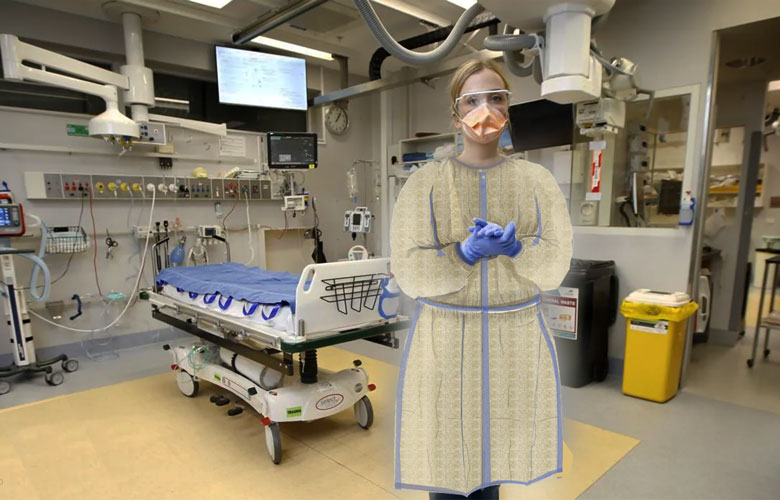RMIT University design students have come up with an award-winning recyclable gown for medicos treating patients with COVID-19.
By Georgina Jerums
A PPE gown that’s produced with low impact on the environment?
Cue the winners of the 2020 Victorian Premier’s Design Awards Student Design Category.

RMIT’s Charlotte McCombe, Tanuj Kalra and Jui Deepak Apte have developed a hospital gown made from the aquatic weed Cumbungi – under the brand name Aegis – that’s addressing the short supply of PPE for medical workers and ensuring the used gowns degrade quickly and safely.
While the trio dreamt up the design during a tertiary class which asked students to “find solutions to current environmental issues through biodesign” their idea goes way beyond the classroom. It answers the problem of global shortages in PPE that’s creating a rise in record amounts of waste from single-use gowns made primarily from petroleum derivatives.
In comparison, Aegis’s PPE alternative is completely biodegradable.
The next step is for the gown design to be prototyped and tested in hospital settings.
“This is our eventual plan, but before we do that we need some lab time to prototype fabric from Cumbungi in the most sustainable way, with minimal impact from chemicals and energy consumption and testing different methods with industrial standard lab equipment, says Charlotte.
“While we want to start in Australia, Cumbungi is abundant across the world,” she continues. “The Aegis model has the potential to produce much-needed healthcare equipment to underserved countries, boosting local industry and decreasing hazardous waste. Our vision is to farm cumbungi using recycled water at a number of locations across Australia, starting with Victoria. Through a network of factories supported by renewable energy sourced from the end-cycle of our own products, we believe we can provide a local solution to the global PPE crisis. Using a type of technology called anaerobic digestion, we plan to work with hospitals to collect used gowns and digest them into products such as biogas and fertiliser, which can go back into fuelling the operations of production or the daily operations of the hospital.”
Q&A: Charlotte McCombe
What was it about the Aegis design that made it win the VPDA award? What made it stand out from the crowd?
We went the extra mile to get our hands dirty and prototype with our biosource, Cumbungi.
A key principle throughout was zero waste; not only in sourcing materials, but also how we manufacture, deliver and dispose of them. Focusing on every aspect of the product lifecycle led to some exciting innovation and design direction, particularly when we could apply it to what we could see happening with the rise of single-use plastic in the COVID-19 crisis and in the future trends of healthcare more broadly.
We think our hands-on attitude was key to the project’s success. From day one, we were super enthusiastic about getting into the kitchen over lockdown and using makeshift tools like blenders and rice-cookers to prototype the fabric, even to the extent of damaging our equipment! This proved that the project had legs and was heaps of fun; our favourite part of the process, for sure.
Ultimately, it was working on the bio-material level that led us to a unique and exciting project.
How far along is it in development?
We’ve been developing a business and have started prototyping our very own bio-constructed and biodegradable fabric out of Cumbungi in Melbourne. We’re in conversation with some different local biotechnology focused labs and trying to build a network with like-minded start-ups and material experts. Once we have a high-fidelity prototype we have plans to expand, but right now we’re looking for grants and contacts in the industry.
What does the Aegis invention say about the state – and promise – of up-and-coming designers in Melbourne?
It says we need to start being really critical about how we find and consume materials. Aegis shows that we don’t need to rely on a distant supply chain and extractive technologies to innovate. Let’s work with biomaterials and repurposed waste products instead!
Where does Melbourne shine when it comes to design and the next generation?
The design landscape in Melbourne is super exciting at the moment. In particular, work in regenerative design and bio-architecture, as spearheaded by RMIT design lecturers such as Dr Ollie Cotsaftis and Dr Piryo Haikolya, is positioning Melbourne as a hub of green innovation. Melbourne has potential to become an international leader in circular economy thinking and design. With climate crisis at the front of everyone’s mind, this is exciting for young designers in particular, allowing us to do our bit to reclaim the future.
Type on the line above then press the Enter/Return key to submit a new search query